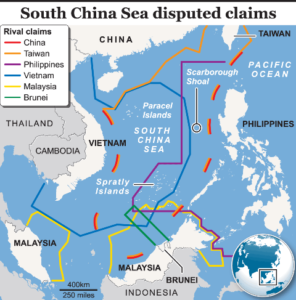In news– Recently, China notified new maritime rules to regulate foreign ships in its waters.
Key highlights of new rules-
- As per the new rules, operators of submersibles, nuclear vessels, ships carrying radioactive materials and ships carrying bulk oil, chemicals, liquefied gas and other toxic and harmful substances are required to report their detailed information upon their visits to Chinese territorial waters.
- In addition to these types of vessels, vessels that may endanger the maritime traffic safety of China prescribed by laws should also follow the new regulation which will take effect from September 1.
- Those vessels should report the name, call sign, current position and next port of call and estimated time of arrival.
- The name of shipborne dangerous goods and cargo deadweight are also required in the report.
- The reference to submersible reportedly refers to spy devices unmanned spy devices found by the Chinese fishermen in China’s coastline.
South China Sea-
- It is a marginal sea that is part of the Pacific Ocean, encompassing an area from the Karimata and Malacca straits to the Strait of Taiwan of around 3,500,000 square kilometres.
- China claims almost all of the 1.3 million square-mile South China Sea as its sovereign territory.
- The ‘nine-dash line’ stretches hundreds of kilometers south and east of its southerly Hainan Island, covering the strategic Paracel and Spratly island chains.
- China buttresses its claims by citing 2,000 years of history when the two island chains were regarded as its integral parts.
- But Vietnam rejects the Chinese argument, justifying its own claims, on the basis of written records, which, in its view, establishes its administration over the area since the 17th century.
- Beijing and Manila clash on account of their dispute over the jurisdiction of the Scarborough shoal, which is 160 kilometres from the Philippines.

- China has been building military bases on artificial islands in the region also claimed by Brunei, Malaysia, the Philippines, Taiwan and Vietnam.
- The South China Sea carries tremendous strategic importance, as one-third of the world’s shipping passes through it.
- It contains lucrative fisheries, which are crucial for the food security of millions in Southeast Asia. Huge oil and gas reserves are believed to lie beneath its seabed
- Major rivers that flow into the South China Sea include the Pearl, Min, Jiulong, Red, Mekong, Rajang, Pahang, Agno, Pampanga, and Pasig Rivers.
Source: Indian Express














